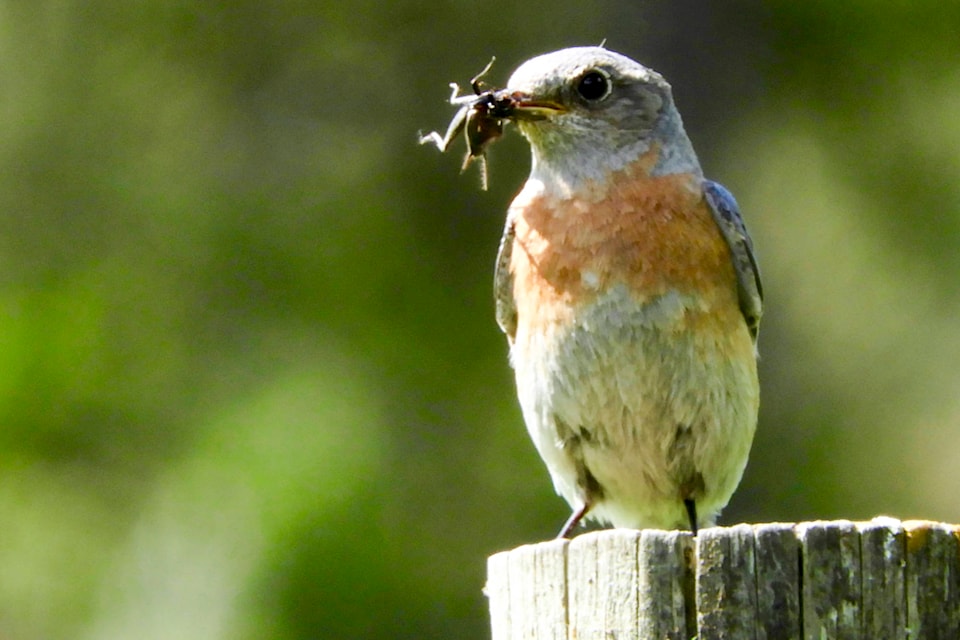Shortly after I arrived in the Okanagan I noticed small odorous house ants on the march. It didn’t take long to find them inside, mysteriously appearing from a tiny crack in a window frame.
I got the caulking gun and sealed that crack. Smugly I assumed the ants would go elsewhere. They did. They found another access point and headed for the kitchen.
All the non-chemical deterrents I could find made little impression. Finally, a pest control company sprayed the base of all perimeter walls, inside and out. I was assured that the spray would have no impact on anything but the ants and other insects.
“It won’t bother the Pacific tree frogs?” I asked nervously. “It won’t bother the birds? Or the yellow racers or garter snakes?”
“Nah,” I was assured. “This stuff has been tested and tested. The birds would have to eat a ton of bugs for it to have any effect.”
Fortunately, I saw lots of tree frogs, birds and snakes around. But by the next spring, the frog, bird and snake populations seemed to have declined.
These avian and earthly wonders make bugs a big part of their diet. The spray had killed the ants all right, and the beetles, spiders, stink bugs, moths, flies, mosquitoes and solifugae, feisty little beasties often mistaken for scorpions.
The lack of bugs appeared to equate with a decline in birds, frogs and snakes.
Of course, my spray project had only a very localized impact and my observations are anecdotal evidence, not the result of complex scientific surveys. But it’s not hard to imagine that a relationship exists. A reduction in food is reason to seek food elsewhere.
It’s interesting to note that 80 per cent of birds are at least partially insectivorous, and for many of those, insects account for 80 per cent of their diet. The balance is topped up with seeds and fruits. Robins, sparrows, finches, bright coloured orioles, the flycatcher family, nighthawks, lazuli buntings, warblers, doves, grouse, swallows and many more thrive on insects.
Some, like western bluebirds, seek insects on the ground and others, like swallows and flycatchers, prefer to feed in the air.
I’ve noticed lots of swallows along the KVR trail between OK Falls and Kaleden. They’re most active over the water near the trestle and along the silt bluffs. There are violet-green swallows, rough and ready northern rough-winged swallows, glossy dark blue tree swallows and rusty breasted barn swallows.
They practice their high-speed dining acrobatics with amazing darts and dashes. Then zero in on flying insects with laser-like focus. I often hear the snap of their beaks when they snatch an airborne insect. With beaks agape, they can swoop through insect swarms for a major mouth-full.
Flycatchers too are masters of aerial feeding, dashing out from a vantage point to neatly pick an insect from the air and occasionally flutter to the ground to grasp a grasshopper.
Surprisingly, hummingbirds too are insectivorous. Only 20 per cent of their diet is nectar!
It seems obvious that if the insect population is removed or declines, there is less food for birds that relish a buggy meal. In fact, lots of birds delay phases of migration and nesting and egg laying until they’re confident of a good insect supply.
It’s like the chicken and the egg story. Which comes first? Do we need insects to feed the birds, or do we need the birds to help control the insect population? If the bird population declines or birds move on, does the insect population increase?
Certainly, some birds make a big difference. Even little wrens have been recorded making 1200 trips to their nest per day. If each visit accounts for only one insect they may be removing 1200 insects a day from their territory.
I’ve seen birds with a wiggly beak full of insects on the way to a hungry brood.
Now if birds could only develop a taste for odorous house ants….
Dianne Bersea is a member of the South Okanagan Naturalists. Views expressed do not necessarily represent SONC. Info on birding events: southokanagannature.com/birding/
